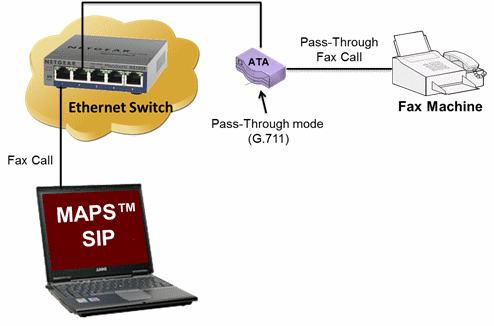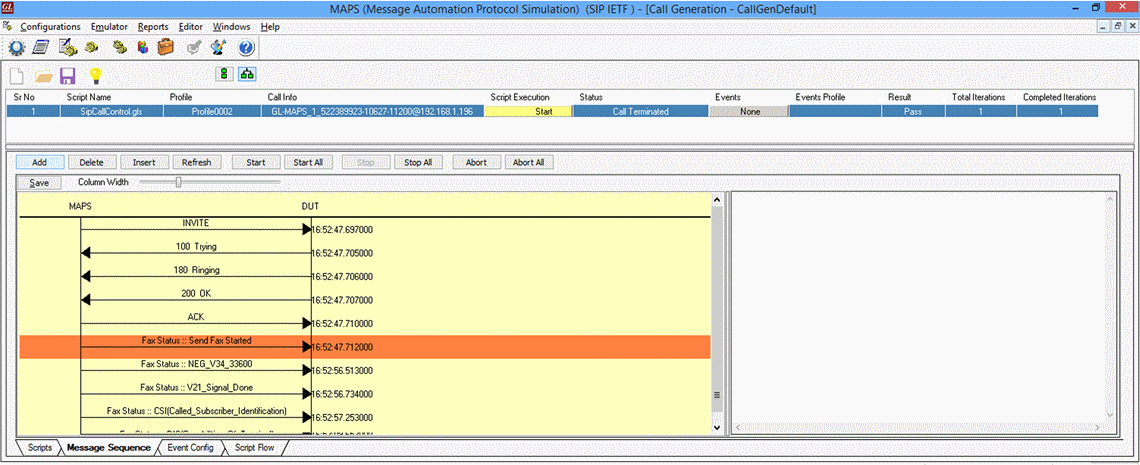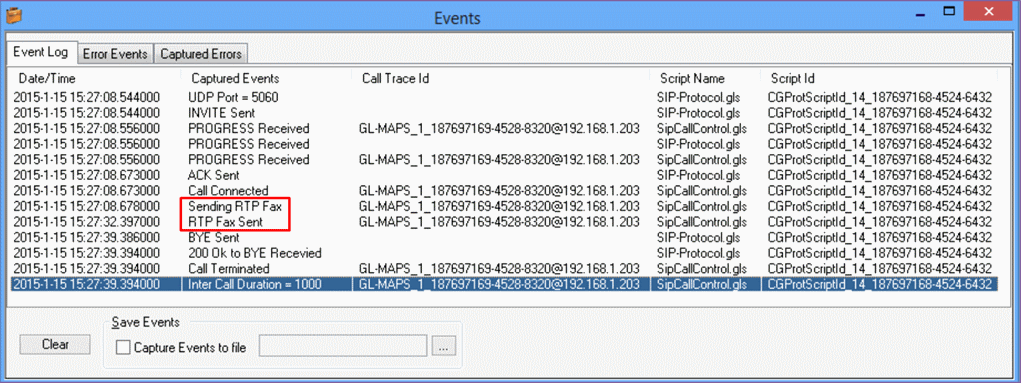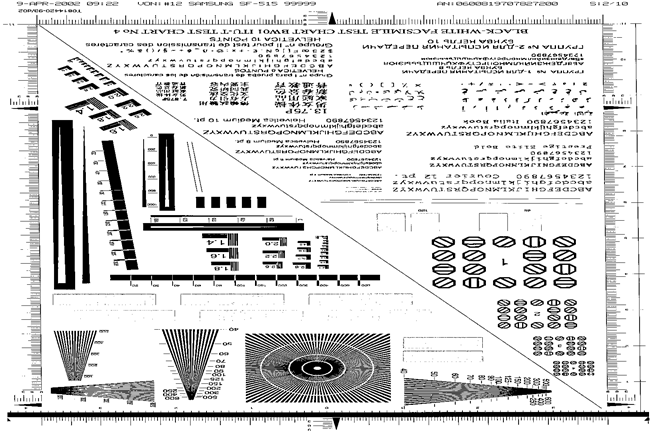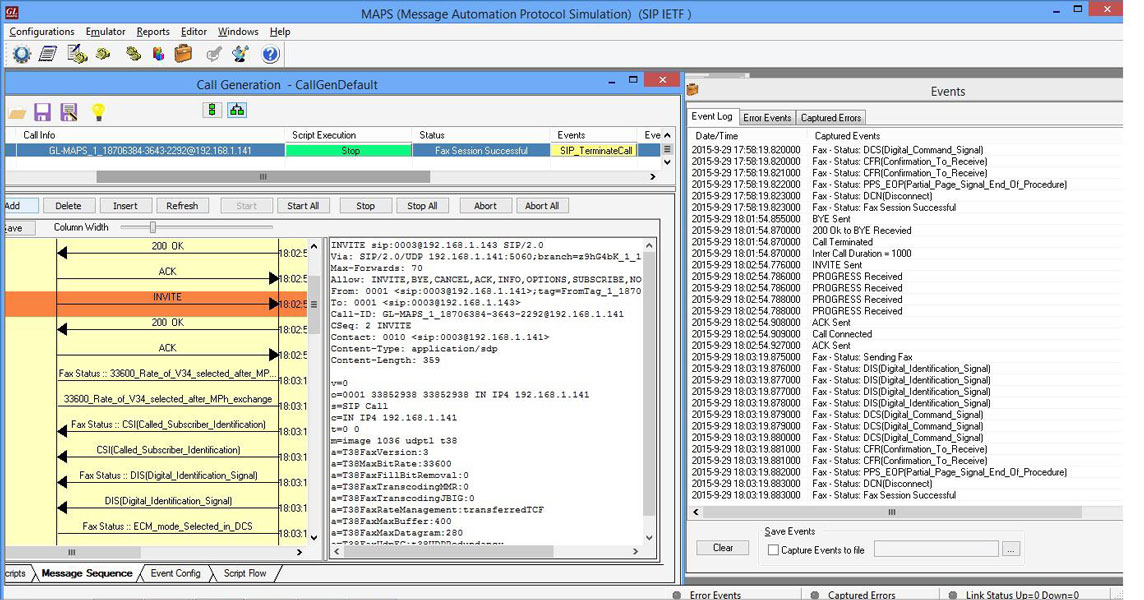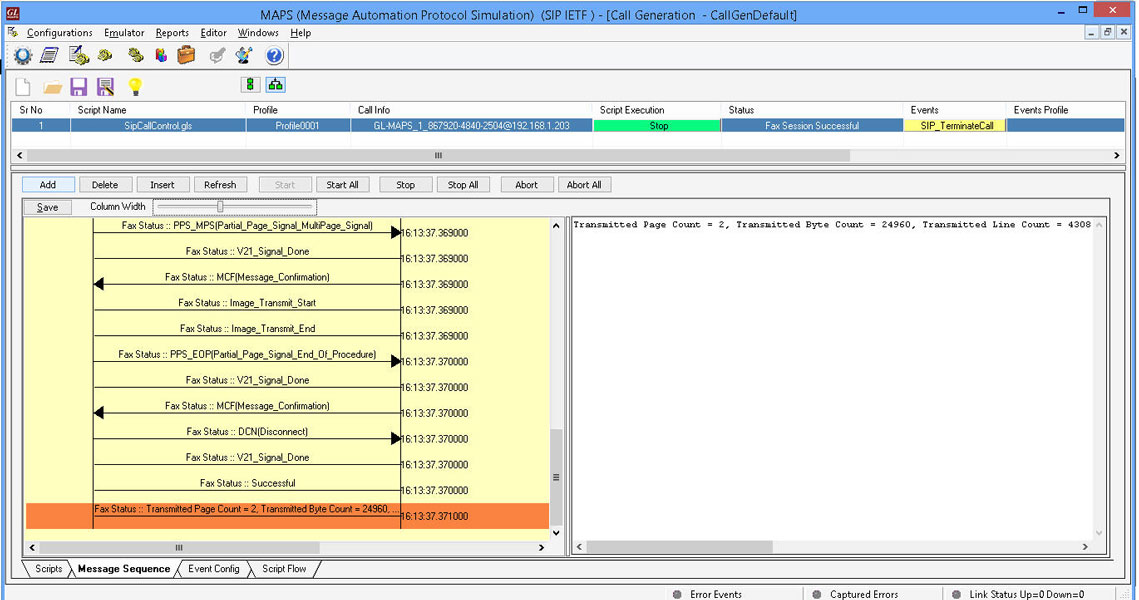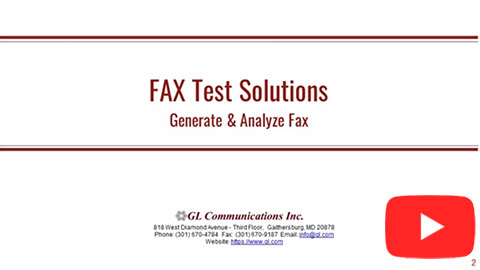Fax Emulation over IP
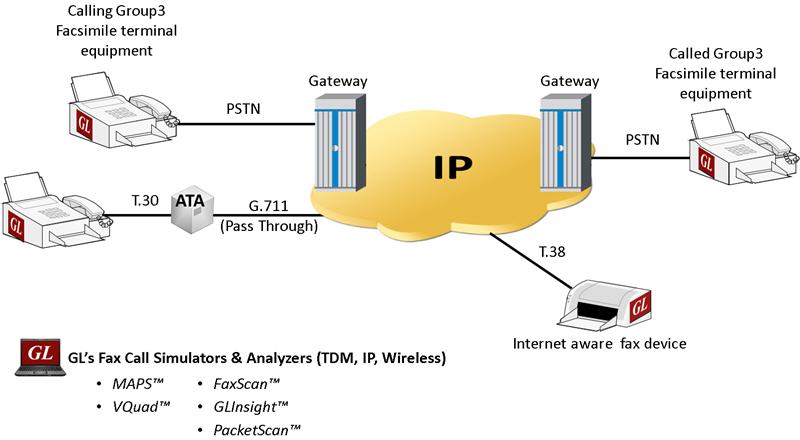
Overview
GL offers a variety of test tools to perform FAX over IP (FoIP) Emulation and monitoring. Fax Emulator supports both RTP G.711 Pass Through Fax Emulation (PKS200) and T.38 Fax Emulation over UDPTL (PKS211). Almost all MAPS™ IP based emulation products supports FAX emulation using any of these two methods. Typical applications of our Fax Emulator include load testing of fax servers, qualification testing of T.38 Gateways, testing of ATAs (Analog Terminal Adapters), testing of internet-aware fax machines, and many more.
With respect to channel capacity RTP pass-through and T.38 fax emulation over UDPTL supports up to 120 concurrent Fax channels.
GL’s RTP Fax Emulator emulates multiple Pass-Through fax calls. Fax Pass-Through mode is a method of transmission of modulated fax data over an IP transport. It works similarly to a PSTN-based fax call with originating FAX machine converting the T.30 fax call to a PCM audio stream using G.711 codec (PCMU and PCMA), and gateway encapsulating the fax data with Real-time Transport Protocol (RTP) headers, before transmitting over IP networks.
With RTP Fax Emulator can transmit pre-recorded Tiff image to the DUT (Real-time Fax machine), receive Pass-Through fax from the DUT, and record complete fax call messages as log file along with a Tiff image.
As Fax is ideally not suited to be transmitted via a normal voice call, the ITU-T T.38 (03/2002) protocol was developed. A robust approach is offered using T.38 Fax Relay Protocol, for transmission of fax over IP, which offered redundancy, re-transmission, and efficiency. Implementation of this protocol uses UDPTL to transport T.38 frames. A T.38 FoIP call is very similar to a normal VoIP (voice) call where a session starts with audio transmission / reception, then switches over to T.38 mode upon fax tone detection, after the completion of which it either falls-back to audio or the session terminates. It is recommended to use T.38 method in FAX calls as opposed to normal voice codecs because voice codecs are lossy and are therefore unreliable for data transition.
The T.38/V.17 configuration operates at the maximum 14.4 kbps speed, whereas the T.38/V.34 operates at the maximum 33.6 kbps speed.
GL also offers Fax Analysis over IP using FaxScan™, PacketScan™, and GLInsight™ applications for both T.38 and T.30 Pass-Through Mode. Refer to Analysis of Fax over IP, TDM, & PSTN webpage for other GL’s Fax emulation and analysis tools.
Important Features
| Fax Standards | V.34, V.21, V.27, V.29, V.8 and V.17 |
|---|---|
| Data Rate | 2400 bps to 33600 bps |
| ECM/nonECM | supported |
| Channel Capacity | For T.30 - 2 to 120 ports supported |
| Page sizes | A4, A3, B4, letter, legal |
| Page Resolutions | 204x98, 204x196, 204x391, 408x391, 200x200, 300x300, 400x400 |
| Error Correction Strategies | T.38 - FEC or Redundancy |
| Rate Management | T.38 - Rate Management 1 (local tcf) or Rate Management 2 (transferred tcf) |
| Compression | Modified Huffman (MH), Modified READ (MR), or Modified-Modified READ (MMR) Encoding |
| Fax Call Quality Statistics | Provides fax call quality parameters like Received Page Count, Received Page Error Count, Received Byte Count, Received Line Count, Received Bad Line Count, Received Bad Pkt Count, Transmitted Page Count, Transmitted Byte Count, Transmitted Line Count |
Fax Emulation Applications
- Load Testing - sending or receiving up to hundreds of faxes simultaneously.
- V.34 Testing - there are many fax modulations and V.34 is the fastest, permitting many pages to be transmitted quickly.
- High Speed / Low Speed - fax protocol consists of low speed handshaking and high speed image transmission
- Multiple Pages - single or multiple page fax transmission is supported
- With or without ECM - Error Correction Mode permits the retransmission of erred pages.
- a-law and µ-law - In TDM networks, USA uses µlaw and the rest of the world use Alaw – both coding standards are supported
- Over PSTN, IP - Fax transmission over PSTN FXO / FXS lines, or over VoIP (packet) networks
- Transmit / Record Tiff image and log Facsimile messages to a log file
Generation of Fax Call using MAPS™ (T.30)
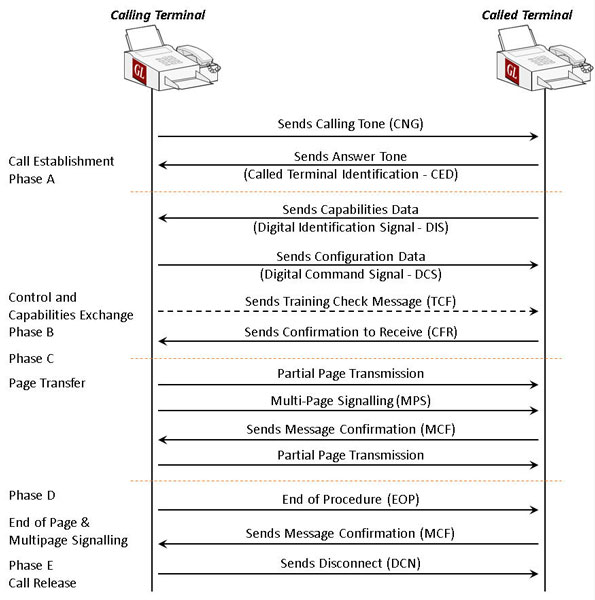
A Typical G.711 Pass Through Mode (T.30) Fax Call Flow
MAPS™ SIP can initiate a typical SIP call to the ATA which is configured for Pass through fax mode. Now the ATA will initiate the call to the connected real time fax machine. Once the call is established, MAPS™ can transmit pre-recorded tiff image in pass-through mode to the fax machine at the other end. Similarly, fax generated from real fax machine can be recorded in the tiff format, and the fax call flow can be analyzed in-detail for further troubleshooting.
MAPS™ allows the user to initiate fax calls by sending call control messages using proper scripts and profiles. The profile allows necessary parameters of call control messages to be changed during runtime. The below figure depicts the fax call being generated using MAPS™ SIP.
MAPS™ allows the user to initiate fax calls by sending call control messages using proper scripts and profiles. The profile allows necessary parameters of call control messages to be changed during runtime. The below figure depicts the fax call being generated using MAPS™ SIP.
Successful Fax Events in MAPS™
The below figure display RTP fax call being transmitted successfully using MAPS™ SIP.
Fax Emulation over IP using GL's MAPS™ Platform (T.38)
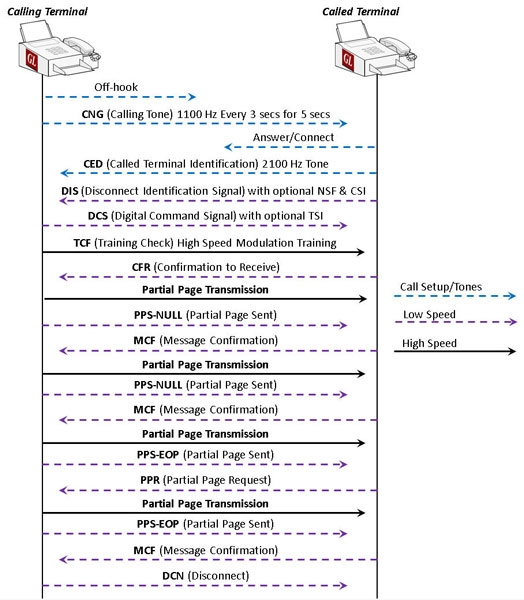
A Typical 2 page T.38 Fax Transaction using ECM Call Flow
The fax call originating in PSTN network from Group3 Facsimile equipment, switches from analogue mode to digital mode between the gateways, and then again falls back to analogue mode in PSTN network at the receiving end. The T.38 Fax relay protocol is used to carry the fax control signals and image data between the gateways over the IP network.
GL’s MAPS™ SIP is a useful tool for emulation of T.38 fax call. It uses SIP signaling to establish the session, and it sticks to standards like ITU-T T.30, ITU-T T.38, ITU-T T.4, ITU-T V.8, ITU-T T.6 during fax call. One could configure MAPS™ to perform different types of action like transmit file, digits, tones or Talk in audio mode before switching over to T.38 mode.
While the call in progress, as depicted in the below screen, the MAPS™ also provides events related to the progress of the call.
Fax Standards
| Standard | Description |
|---|---|
| V.17 | High speed data transmission used for high transfer rates of High Speed (HS) fax page data (9600 to 14400 bps) |
| V.27 | It uses a data signaling rate of 4800 bps with eight phases differentially encoded modulation and operates at a reduced rate of 2400 bps with four phase differentially encoded modulation. |
| V.29 | High speed data transmission used for medium transfer rates of High Speed (HS) fax page data (4800 to 9600 bps). |
| V.33 | High speed data transmission, fax page data (1200 to 1440bps). Used for synchronous data transmission. |
| V.34 | High speed data transmission, fax page data (). Used for Sync/Async data transmission. |
ITU Standard
| Data Rates (Kbps) | V.27 V.29 |
V.17 | V.34 V.34 bis |
|---|---|---|---|
| 2.4 | X | X | |
| 4.8 | X | X | |
| 7.2 | X | X | X |
| 9.6 | X | X | X |
| 12 | X | X | |
| 14.4 | X | X | |
| 16.8 | X | ||
| 19.2 | X | ||
| 21.6 | X | ||
| 24 | X | ||
| 26.4 | X | ||
| 28.8 | X | ||
| 31.2+ | X | ||
| 33.6+ | X |
Supported File Formats
- G.711 A-law encoded 8-bit samples.
- G.711 µ-law encoded 8-bit samples
- 16-bit linear samples that utilize only the low 13 bits. The upper 3 bits are sign extended.
- 16-bit linear samples utilizing all 16-bits
- Fax Image Output – Class-F TIFF format as specified in RFC 2301
- Pcap, ngpcap file format for T.38
Please Note: The XX in the Item No. refers to the hardware platform, listed at the bottom of the Buyer's Guide, which the software will be running on. Therefore, XX can either be ETA or EEA (Octal/Quad Boards), PTA or PEA (tProbe Units), XUT or XUE (Dual PCIe Express) depending upon the hardware.
| Item No. | Item Description |
| PKS200 PKS202 PKS203 PKS204 PKS205 PKS206 |
RTP Pass Through Fax Emulation requires one of the licenses below, (w/dongle) Fax Port Licences (2 Fax Ports, RO) Fax Port Licences (8 Fax Ports, RO) Fax Port Licences (30 Fax Ports, RO) 60 Fax Ports, RO 120 Fax Ports, RO |
| PKS211 | T.38 Fax Emulation over UDPTL (unlimited channels, CPU constrained) |
| Related Software | |
|---|---|
| FXT001 | GL Insight™ - Single Fax Analysis - TDM |
| FXT002 | GL Insight™ - Single Fax Analysis - IP |
| VQT022 | VQuad™ 2 Ports Fax Emulation (2-wire, & 4-wire) |
| VQT022a | VQuad™ 8 Ports Fax Emulation (2-wire, & 4-wire) |
| PKB100 | RTP ToolBox™ Application |
| PKS120 PKS122 PKS124 PKS160 PKS137 PKS126 |
MAPS™ SIP Emulator MAPS™ MEGACO Emulator MAPS™ MGCP Emulator MAPS™ UMTS IuCS, MAPS™ UMTS IuH MAPS™ GSM A over IP MAPS™ SIP I |
